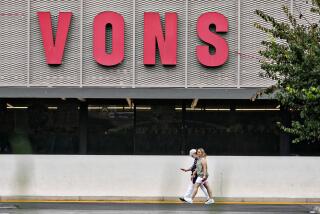Filling in ‘food deserts’
- Share via
For decades, residents of South Los Angeles have had few places in their neighborhoods to shop for groceries. British supermarket giant Tesco, which is opening its first stores in the United States this week, claims it will help narrow this persistent grocery gap.
Tesco, the third-largest food retailer in the world, has ambitious plans: about 70 Fresh & Easy Neighborhood Market stores in the next year, at an estimated initial cost of about $2 billion. The first six open Thursday in Southern California, with eight more to follow in Arizona and Nevada by the end of November.
At news conferences and public meetings, Tesco has promised to locate some of its outlets in areas that are desperate for them, such as South L.A. Researchers call these high-poverty areas “food deserts” -- that is, places where the heavily transit-dependent population has no full-service grocery within a half-mile walk of their homes.
Tesco’s plans have been applauded by the media and policymakers in some cities as a long-overdue response to a significant inner-city problem. And it’s good PR for Tesco too. Tim Mason, who heads Tesco’s U.S. operations, admitted as much to the Sunday Observer, a British newspaper. “One of the reasons we appeal to American politicians,” Mason said, “is because we have said we will go back into neighborhoods that have become ‘food deserts.’ ”
In Los Angeles, Tesco’s promises might have a familiar ring. After the 1992 Los Angeles riots, four major supermarket chains, under the auspices of the Rebuild L.A. initiative, promised to build 32 supermarkets in the affected neighborhoods -- many of which had been underserved since the 1960s.
But 10 years later, those neighborhoods were in virtually the same straits. There was no net gain of markets, and one chain, Vons (now owned by Safeway) had pulled out of low-income areas altogether. Research we completed earlier this year documented how low-income areas still lack access to fresh, healthy and affordable food -- a problem that is compounded by a concentration of liquor stores and fast-food outlets.
This history of broken promises prompted us to look closely at Tesco’s plans.
Of the 13 Fresh & Easy Neighborhood Market stores opening this month, only one -- in the Riverside County town of Hemet -- is in a census tract with a significantly higher-than-average poverty rate. But Hemet is no food desert; two major supermarkets (Albertsons and Smart & Final) are about half a mile away. Another store, opening in L.A.’s mixed-income Glassell Park neighborhood, fills a serious void; two supermarkets recently closed in that area.
It is the site at Adams Boulevard and Central Avenue -- an area affected by the ’92 unrest -- that has received the most attention. But that site is in limbo; a Tesco spokesman told community groups that it could take several years to open a store there.
Take a look at the map of Los Angeles-area locations on freshandeasy.com. There’s a ring of 16 stores, mostly suburban -- stretching from Moorpark to Rancho Cucamonga to San Pedro. And then there’s a gaping hole in the middle: South and Central Los Angeles. The Sahara of food deserts.
Our politicians and community leaders can do more to make sure that Tesco -- indeed all supermarket chains -- don’t leave things this way. The same policies some cities use to create affordable housing could work for affordable food: As part of any development or expansion, a company must build in underserved areas or pay into a fund to subsidize retailers that will.
Neighborhood stakeholders also can insist on binding community-benefits agreements -- deals that a coalition of local organizations reach with a company before development begins. Groups agree not to oppose a development, and in exchange, for example, a company commits to hiring local workers, paying a living wage and operating environmentally sensitive buildings. It’s not an outrageous notion; Philip Anschutz’s AEG signed just such an agreement during the planning phase of L.A. Live in downtown. But, so far, Tesco hasn’t negotiated with the Alliance for Healthy and Responsible Grocery Stores.
It’s not just Adams and Central that needs a market. So does Boyle Heights. So does MacArthur Park. So do Athens and Hyde Park and Florence.
Certainly, Tesco should be applauded for going into some low- and mixed-income neighborhoods that have been overlooked by other retailers. But there are many more that need them. As Fresh & Easy’s motto says: “Everyone deserves fresh, healthy food.”
More to Read
Inside the business of entertainment
The Wide Shot brings you news, analysis and insights on everything from streaming wars to production — and what it all means for the future.
You may occasionally receive promotional content from the Los Angeles Times.










